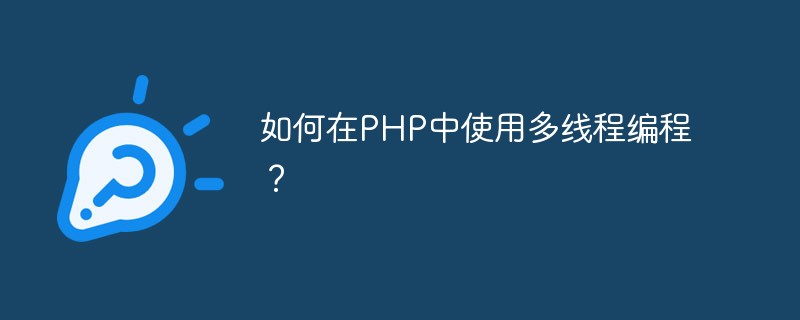 Java
Java javaTutorial
javaTutorial Summary and suggestions of concurrent programming experience in Java development
Summary and suggestions of concurrent programming experience in Java development
In Java development, there is an increasing demand for concurrent programming. As multi-core processors become more common, developers need to make better use of concurrent programming to improve system performance and responsiveness. However, concurrent programming also brings a series of challenges and problems, such as thread safety, deadlock, race conditions, etc. In this article, I will summarize some of my concurrent programming experiences in Java development and give some suggestions.
First of all, for concurrent programming, it is crucial to understand the basic concepts of multithreading. A thread is the smallest unit for scheduling by the operating system, and it represents an independent execution thread. The emergence of multi-threading allows programs to perform multiple tasks at the same time, improving the efficiency of the system. However, multithreading also introduces new problems, such as access conflicts of shared data and inter-thread communication. Therefore, we must have a deep understanding of the life cycle of threads, state transitions, and interaction mechanisms between threads.
Secondly, thread safety is one of the most important issues in concurrent programming. Multiple threads accessing the same shared variable at the same time may cause data inconsistency. In order to ensure thread safety, we can use various methods, such as locking, using atomic operations, using thread-safe containers, etc. In Java, we can use synchronized keyword to achieve thread safety. However, excessive use of synchronized may cause performance problems, so we need to choose the appropriate synchronization mechanism according to specific scenarios.
In addition, deadlock is one of the common problems in concurrent programming. Deadlock refers to the inability of multiple threads to continue execution because they are waiting for each other to release resources. In order to avoid deadlock, we can adopt the following strategies. First, avoid circular waiting, that is, ensure that threads apply for resources in a specific order. Secondly, use a lock with a timeout mechanism to avoid waiting because the thread cannot obtain the lock. Finally, through reasonable design of lock granularity, the possibility of competition is reduced, thereby reducing the occurrence of deadlock.
In addition, race conditions are also issues that need attention in concurrent programming. Race conditions refer to the uncertainty and different results produced by multiple threads in the order of execution. In order to avoid race conditions, we can use the volatile keyword to solve the visibility problem of variables. In addition, the java.util.concurrent package provides a large number of thread-safe classes, such as ConcurrentHashMap, CountDownLatch, Semaphore, etc., which can help us better manage concurrency.
Finally, in order to reduce problems in concurrent programming, we can adopt the following suggestions. First of all, try to avoid using violent thread operations, such as stop(), suspend(), etc., because these operations may cause the thread to be in an inconsistent state. Secondly, set the thread priority appropriately to prevent low-priority threads from occupying CPU resources for a long time. Also, try to avoid using global variables as they increase the likelihood of conflicts in shared data.
To sum up, concurrent programming in Java development is a complex and critical issue. By in-depth understanding of the mechanisms and characteristics of multi-threading, reasonable selection of synchronization mechanisms and lock management strategies, and following some concurrent programming experiences and suggestions, we can better handle concurrency issues and improve system performance and stability.
The above is the detailed content of Summary and suggestions of concurrent programming experience in Java development. For more information, please follow other related articles on the PHP Chinese website!
 Golang语言特性揭秘:并发编程与多线程同步Jul 17, 2023 am 09:48 AM
Golang语言特性揭秘:并发编程与多线程同步Jul 17, 2023 am 09:48 AMGolang语言特性揭秘:并发编程与多线程同步Golang是一种现代化的编程语言,被设计用于解决大规模并发问题。它的并发编程模型让开发人员可以轻松地创建并管理多个goroutine,实现高效的并发执行。在本文中,我们将揭秘Golang的并发编程特性,并探讨如何在多线程中进行同步。Golang的并发编程模型基于goroutine和channel。gorouti
 如何在PHP中使用多线程编程?May 12, 2023 am 08:39 AM
如何在PHP中使用多线程编程?May 12, 2023 am 08:39 AM随着Web应用程序变得越来越庞大和复杂,传统的单线程PHP开发模式不再适用于高并发处理。在这种情况下,使用多线程技术可以提高Web应用程序处理并发请求的能力。本文将介绍如何在PHP中使用多线程编程。一、多线程概述多线程编程是指在一个进程中并发执行多个线程,每个线程都能单独访问进程中的共享内存和资源。多线程技术可以提高CPU和内存的使用效率,同时可以处理更多的
 Java线程池的并发编程技巧与应用实践Jun 15, 2023 pm 11:25 PM
Java线程池的并发编程技巧与应用实践Jun 15, 2023 pm 11:25 PMJava线程池的并发编程技巧与应用实践随着互联网和移动互联网的普及,并发访问量变得越来越大,传统单线程编程方式已经无法满足大规模并发的需求。Java线程池充分利用CPU资源,实现高效并发编程,是面向对象编程中不可或缺的一部分。本文从Java线程池的基本原理入手,介绍了线程池的核心参数配置、使用方法、线程池的应用场景及其优化策略。一、Java线程池基本原理J
 如何利用 Go 语言进行并发编程?Jun 10, 2023 am 10:33 AM
如何利用 Go 语言进行并发编程?Jun 10, 2023 am 10:33 AM随着计算机硬件的不断发展,处理器中的CPU核心不再单独增加时钟频率,而是增加核心数量。这引发了一个显而易见的问题:如何发挥这些核心的性能?一种解决方法是通过并行编程,即同时执行多个任务,以充分利用CPU核心。这就是Go语言的一个独特之处,它是一门专为并发编程而设计的语言。在本文中,我们将探讨如何利用Go语言进行并发编程。协程首先,我们需要了解
 PHP中的并行编程技术May 23, 2023 pm 07:21 PM
PHP中的并行编程技术May 23, 2023 pm 07:21 PM随着互联网的快速发展,大型Web应用程序的开发变得越来越流行。在这种情况下,一个Web应用程序需要处理来自数百甚至数千个用户的请求。这就需要并行编程技术,以便在处理多个请求时提高程序的性能。PHP是一个流行的脚本语言,广泛用于Web应用程序的开发。PHP提供了多种并行编程技术,包括多进程、多线程和异步编程。在本文中,我们会介绍这些技术,以及它们如何帮助我们实
 如何使用PHP7.0进行并发编程?May 28, 2023 am 08:51 AM
如何使用PHP7.0进行并发编程?May 28, 2023 am 08:51 AMPHP7.0是当前最常用的服务器端编程语言之一。它界面友好、易于学习,功能强大,具有丰富的扩展库。在并发编程方面,PHP7.0也有许多优秀的工具和技术。本文将介绍如何在PHP7.0中进行并发编程。一、什么是并发编程并发编程是指通过多个线程,进程或协程等方式,使多个任务在同一时间内同时执行的编程方式。在编程中,有效地使用并发技术可以提高程序的性能和吞吐量。二、
 Golang并发编程探索之Goroutines的线程模型详解Jul 17, 2023 pm 10:24 PM
Golang并发编程探索之Goroutines的线程模型详解Jul 17, 2023 pm 10:24 PMGolang并发编程探索之Goroutines的线程模型详解在当今互联网时代,高并发成为了各种系统开发中非常重要的一个课题。传统的单线程编程模型很难以满足大量并发请求的需求,而在很多编程语言中,多线程编程也存在着复杂的竞态条件、死锁等问题。而在Golang中,通过轻量级的Goroutines和基于通信的并发模型,使得并发编程变得更加简单和高效。Gorouti
 在Beego中使用Akka实现并发编程Jun 23, 2023 am 08:16 AM
在Beego中使用Akka实现并发编程Jun 23, 2023 am 08:16 AM随着互联网的不断发展,高并发和分布式是大多数Web应用程序所面临的挑战。许多框架和工具已经被开发出来,以便用于解决这些挑战,而在这些框架和工具中,Beego和Akka是非常好的例子。Beego是一个开源的Web应用框架,而Akka是一个强大的并发编程框架,它能够使分布式应用程序更容易开发和维护。本文将介绍如何在Beego中使用Akka来实现并发编程。一、A


Hot AI Tools

Undresser.AI Undress
AI-powered app for creating realistic nude photos

AI Clothes Remover
Online AI tool for removing clothes from photos.

Undress AI Tool
Undress images for free

Clothoff.io
AI clothes remover

AI Hentai Generator
Generate AI Hentai for free.

Hot Article

Hot Tools

SAP NetWeaver Server Adapter for Eclipse
Integrate Eclipse with SAP NetWeaver application server.

PhpStorm Mac version
The latest (2018.2.1) professional PHP integrated development tool

DVWA
Damn Vulnerable Web App (DVWA) is a PHP/MySQL web application that is very vulnerable. Its main goals are to be an aid for security professionals to test their skills and tools in a legal environment, to help web developers better understand the process of securing web applications, and to help teachers/students teach/learn in a classroom environment Web application security. The goal of DVWA is to practice some of the most common web vulnerabilities through a simple and straightforward interface, with varying degrees of difficulty. Please note that this software

SublimeText3 English version
Recommended: Win version, supports code prompts!

ZendStudio 13.5.1 Mac
Powerful PHP integrated development environment





